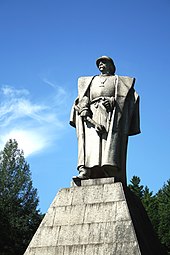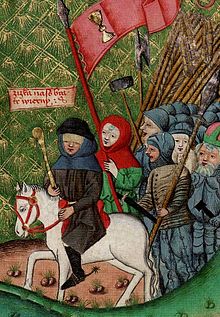Jan Žižka
Jan Žižka von Trocnov [ˈʒɪʃka] (* around 1360 in Trocnov , South Bohemia ; † October 11, 1424 near Šenfeld ; also Žižka the one-eyed , Jan Žižka from the chalice , Czech: Jan Žižka z Trocnova , Jan Žižka z Kalicha ) was the most important General of the Hussites in the Hussite Wars .
Life
origin
Zizka came from an impoverished South Bohemian gentry sfamilie. His early life is not well documented. From 1390 he was initially in the service of the Bohemian King Wenceslaus IV. In 1410 he followed Johann Sokol von Lamberg and entered the service of Władysław II Jagiełłos . He is referred to as blind in some sources about the Hussite Wars, but was one-eyed during the first years of the conflict and only became blind in 1421 after losing his second eye (see below).
The chronicler Andreas von Regensburg describes him with the words: "He was one-eyed, in terms of origin and way of life, neither a nobleman nor a robber, colloquially a 'one-horse' who once had a horse and another time ..."
From 1412 he served again as the castle captain of Prague in royal Bohemian services. Jan Žižka was a follower of the teachings of Jan Hus and after his execution in 1415 he became the spokesman for the Hussite movement.
Hussite Wars

When a Hussite preacher was hit by a Hussite preacher on July 30, 1419 from the New Town Hall , Žižka had the building storm and ten people thrown out the window, where they were impaled by the angry crowds. This process went down in history as the first lintel in Prague .
Žižka initially went to Pilsen with other supporters . In December 1419, near the town, at Nekmíř , he achieved his first military success against a royal unit that was superior in several ways. When they had to leave Pilsen, the Hussites moved to Tábor . On the way there, Žižka succeeded on March 25, 1420 near Sudoměř in South Bohemia, to beat a numerically clearly superior army of Catholics. Characteristic of his combat tactics were the construction of wagon castles and other new war techniques. His own religious convictions and the certainty of victory as a “warrior of God” also contributed to his success. He and the Taborites under his leadership never lost a battle, which earned Žižka the reputation of being invincible.
In Tábor the experienced military leader Žižka was elected a captain of the Hussites.
After the death of King Wenceslas IV , the Bohemian estates paid homage to his brother Sigismund as the new king in Brno in 1420 . However, Sigismund did not enter into negotiations with the rebels in Prague and Tábor. Instead, he sent a criminal court from Breslau against the Hussites, whom he regarded as heretics. Under Žižka's leadership, they succeeded in defeating a royal army sent into the country on St. Vitus Hill near Prague on July 14, 1420 and defending the city.
In the same year the Chiliastic Taborites under the military leadership of Žižka began to use force in the area of Tábor against more moderate groups within the Hussite movement as well as against Catholics who continued their rites. This led to a scandal with the Calixtines in Prague's old town and u. a. As a result, the beginning of 1421 for the expulsion of the radical core of the Taborites around Martin Húska from Tábor by the local "new authorities" (Jan Žižka, Nikolaus von Pelgrims , Jan z Jičína ) and in the spring of 1421 for the de facto extermination of Húska's followers in neighboring villages by Žižka's troops . Torture and execution at the stake of Húskas, which was popular in Tábor as in Prague, was left to the Catholic Archbishop of Prague Konrad von Vechta in Roudnice by Žižka and the Calixtine nobles . Also in the spring of 1421, on March 16 (Palm Sunday), the town of Chomutov was taken by Žižka's troops. On his orders, all but 30 of the city's 2,500 or so residents were massacred - as many as were necessary to bury the rest.
Žižka slandered the followers of Húska's murdered by him as allegedly systematic fornication " Adamites " and as " picards " (after religious refugees from Picardy , from whom they are said to have derived their " heresy "). After his death in October 1424, Žižka himself became - after his death in October 1424, as a leader of the between Taborites - in order to distinguish him from the initially radical Taborites and thus at least partially for the noble and bourgeois Czech nationalities who believe themselves in the tradition of the Calixtines and Calixtiners located “ Orebiten ”, whose existence can not be proven, especially since Žižka worked from Tábor.
He was one of the members of the Čáslav ( Tschaslau ) assembly of estates , which in 1421 deposed King Sigismund as King of Bohemia in the Peter and Paul Church and declared him an undesirable person. Žižka was a member of the 20-person provisional government of Bohemia.

During the siege of the Rabí Castle near Sušice ( Schüttenhofen ), Žižka also lost his second eye in 1421, but this did not prevent him from leading the Hussite armies. After the conquest of the castle Kalich ( chalice ) in Litomerice in 1421 he let them rebuild, where he took his seat and called himself Žižka of Kalich (Zizka from the cup). In the battle at Strauchův or Strachův Dvůr near Königgrätz on August 4, 1423, another attempt by more moderate forces of Bohemia to defeat Žižka failed. In the battle of Maleschau on June 7, 1424, he defeated an army of the master unit and the Prague Hussites.
death
During the siege of Přibyslav ( Primislau ) the blind military leader died of a plague infection near Žižkovo Pole . A large stone cross was erected on the place of his death. Žižka was buried in the Church of St. Peter and St. Paul in Čáslav in 1424 .
“The common sag, which was initially noted by Enea Silvio Piccolomini in his Historica Bohemica and then taken up by Johannes Aventinus , namely that Jan Žižka had ordered his skin to be pulled over a drum after his death, can be seen as emblematic for the performance that one associated with the Hussites. "
Memorials

- Žižka's birthplace south of Trocnov is a national cultural monument . The statue in Trocnov, where he was born, was created by Josef Malejovský in 1960.
- Žižka's tomb existed until 1623, when Emperor Ferdinand II had it removed and destroyed.
- A tomb was erected for him one kilometer south of the village of Šenfeld near Přibyslav, in which his remains were placed. On September 20, 1874, the Jan Žižka monument financed by Jan Otto was unveiled there. In 1921 the village of Šenfeld ( Schönfeld ) was renamed Žižkovo Pole ( Zischka Field ) in his honor.
- In 1925 a 16 m high stone monument to Žižka was erected on the Sudoměř battlefield .
- Vitusberg Vrch Žižkov was named in honor of Žižka . The adjacent Prague district is now called Žižkov
- In the Czech Republic, numerous other places, squares and streets bear the name Žižkas.
National monument on Vitusberg
The national monument with a 9 m high and 16.5 ton heavy equestrian statue of Jan Žižka from 1931, which is considered to be one of the largest bronze statues in the world, is located on Veitsberg ( Vítkov ) in Prague . The idea for this monument originated in 1877, but the complex was not completed until 1950 under the communist regime. The Stalinist rulers of the post-war period set up a memorial in the memorial for selected deceased members of the Czechoslovak Communist Party (for example, the head of state Klement Gottwald, who died in 1953, was embalmed and buried in the national memorial ). The communists' remains were removed after the Velvet Revolution in 1990 . Because of its history, the monument is one of the most unpopular monuments in Prague.
literature
- Constantin von Wurzbach : Žižka von Trocznow, Johann . In: Biographisches Lexikon des Kaiserthums Oesterreich . 60th part. Imperial and Royal Court and State Printing Office, Vienna 1891, pp. 195–199 ( digitized version ).
- Alois Jirásek : Against all the world. Roman Aufbau, Berlin 1956 (German by Josef Zivný & Egon Jiřiček) The dust jacket uses the famous painting by Mikoláš Aleš from 1908, which is shown in this lemma. First German 1911 (other novels by Jirasek also deal with Žižka).
- Petr Klučina: Jak válčili husité. Prague 1983.
- Ralf Höller: I am the fight. Rebels and revolutionaries from six centuries. Berlin 2001, pp. 11–38: Jan Žižka.
- Lutz Mohr : The Hussites in Upper Lusatia with special consideration of their campaigns in the years from 1424 to 1434. Special publication No. 2 of the series: History and stories from Neusalza-Spremberg. Greifswald and Neusalza-Spremberg 2014.
- Miloslav Polívka : Žizka v. Trocnov, Jan. In: Biographisch-Bibliographisches Kirchenlexikon (BBKL). Volume 14, Bautz, Herzberg 1998, ISBN 3-88309-073-5 , Sp. 557-558.
Web links
- Lothar Martin: Tábor About Hussites, Taborites and Jan Žižka on Radio Prague from March 16, 2002 (German).
- About Jan Žižka ( Memento from September 18, 2010 in the Internet Archive )
Individual evidence
- ↑ Jan Žižka at Grunwald: from mercenary to Czech national hero . Radio Prague. July 16, 2010. Retrieved August 16, 2012.
- ^ Dominik Dorfner: Hussites. From the stake in Constance to the fire sites in the Upper Palatinate. Accompanying volume for the exhibition in the pilgrimage museum Neukirchen b. Holy Blood and in the Schwarzachtaler Heimatmuseum Neunburg v. Forest. Neukirchen b. Hl. Blut 1998, Pilgrimage Museum, p. 31.
- ↑ Michaela Bleicher: The Duchy of Lower Bavaria - Straubing in the Hussite Wars - everyday war life and warfare as reflected in the land clerk accounts. Regensburg 2004, 382 pages ( PDF file on d-nb.info).
- ↑ Jan Žižka von Trocnov - monument on visittabor.eu (German).
- ↑ Žižkadenkmal in Sudoměř on jiznicechy.org (Czech, English, German).
- ↑ National Memorial on the Vítkov Hill Memorial on St. Vitus Hill in Prague at nm.cz (English).
| personal data | |
|---|---|
| SURNAME | Žižka, Jan |
| ALTERNATIVE NAMES | Žižka the one-eyed; Žižka from the chalice, Jan; Žižka z Trocnova, Jan (Czech); Žižka z Kalicha, Jan |
| BRIEF DESCRIPTION | Bohemian general of the Hussites |
| DATE OF BIRTH | around 1360 |
| PLACE OF BIRTH | Trocnov , South Bohemia |
| DATE OF DEATH | October 11, 1424 |
| Place of death | Schönfeld |


